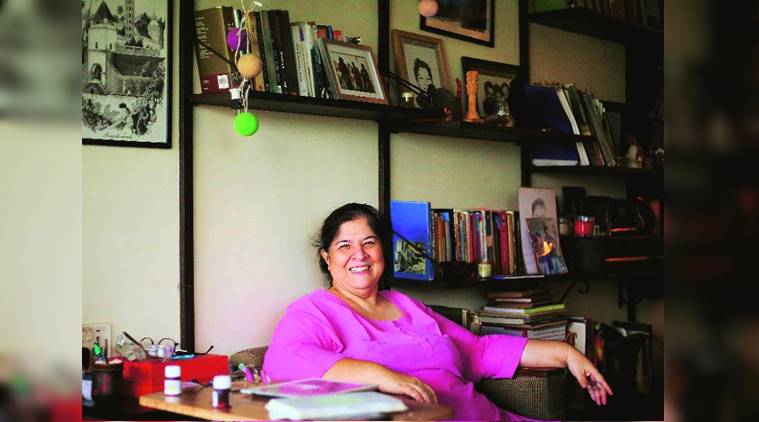All Roads Lead to The Walled City
Theatre veteran Anamika Haksar on directing her debut film, documenting Old Delhi and why introspection and dialogue is the need of the hour.

World as we knew it: Anamika Haksar (Express photo by Amit Chakravarty).
The Camera zooms in to a close-up of clogged drains, with a litany of choicest abuses in the backdrop. It pans out and closes in on men asleep, dotting every available flat surface — cycle thelas, steps of a makeshift tarpaulin barsati. Goddess Lakshmi showers marigold flowers on the sleeping men, as a red floating banner hits her in the face. A man holds high a red flag — a recreation of the iconic image from the Russian Revolution — women picking rags, lying on them. The real is interspersed with the fantastical as corpses wrapped in white cloth are suspended mid-air, people atop a roof fly imaginary kites, and, among the faces of 400 non-actors one comes across the familiar veteran actor Raghuvir Yadav (Chaddami). The crowd, the noise and the crammed lives of the migrants of Purani Dilli aka Shahjahanabad form the soul and spine of theatre doyenne Anamika Haksar’s debut film Ghode Ko Jalebi Khilane Le Ja Riya Hoon, which will be screened at the MAMI Mumbai Film Festival starting October 25.
“Since as long as I can remember, I have been fascinated by the life of Old Delhi. Ancestrally, of course, there was a connect, as my grandfather lived there — though they had moved out by the time we grew up. Par inn ilaakon mein aana-jaana laga rehta thha (We would frequent the area),” says Haksar, 59.
A veteran with a career spanning four decades, Haksar blends old-school documentary-style storytelling with elements of fantasy and theatre. The three protagonists — a food vendor, a pickpocket and a daily-wage loader — hail from various parts of India. “The sheer number of lives that exist there is an extraordinary amalgam. For sometime after my marriage, I stayed in that area and used to look at the rooftops where the migrant labourers slept. I think that’s when this idea really started,” says the National School of Drama graduate (1979-82).
“It could have been either social work or theatre. I was always interested in communication and people. Theatre appealed to me,” says Haksar, who has lived in Nigeria, Vienna and London before returning to India at the age of seven. “My dad was a lawyer and a diplomat, and, my mother, a teacher. From an early age, we had an exposure to theatre veterans Habib Tanvir and (Ebrahim) Alkazi sa’ab, who would frequent our house.”
The title Ghode Ko Jalebi Khilane Le Ja Riya Hoon is an ode to the multiculturalism of the Walled City and a hat-tip to the humour woven in the way people converse. “The story of the title was narrated to me by an aunt, who would go to Purani Dilli to learn Hindustani classical music. Once she hailed a tonga and asked ‘Arre bhaiya kahan jaa rahe ho (where are you going)?’. The tongawallah responded, ‘Arre bibi, ghode ko jalebi khilane le ja riya hoon (I am taking the horse to eat jalebis)’. This was 35 years ago and this just stayed with me.”
It took Haksar three years to research the film. “I roped in my friends (actor) Lokesh Jain and (street theatre artiste) Sarita Sahi, who really helped (in research and dialogue writing) and with understanding the social and economic aspects of migration. They (migrants) come to sell their labour. But what are their aspirations, their dreams, their fears?” says Haksar.
For Patru, the pickpocket, Dubai seems to be the promised land where problems get resolved. For kachori-seller Chaddami, his livelihood is an invocation of Goddess Lakshmi. The historian, who, in white kurta pajama, speaking chaste Urdu, takes people on heritage walks around the old quarters, is a commentary on that which keeps alive the old-world romanticism and a dig on the new-age concept. “The dreams and the dialogues that you hear, about 80 per cent of it is what we heard while we researched. Patru’s dialogues about maut kya hai, zindagi hi toh hai — we heard from a pickpocket himself. The things you see are all real in spite of the film being fictional in its format,” she says.
Also underlining the narrative are allusions to the country’s current socio-political scenario. Documentation for the labourers, for instance, is a subtle nudge at Aadhaar, as is the threat to India’s secular culture. The tribals being deprived of their land in Jharkhand also gets a mention. “I come from Kashmir, and while growing up, there was a whole culture of being secular. But there is such a big divide right now. I remember an incident when this young boy came running to me, I was sitting in an e-rickshaw, and I think it was a dialogue from a Kabir Khan film, ki kuch kariye na, thodi nafrat ghataiye naa (Please do something, reduce the hatred). I was in tears. I wish I could do something,” says Haksar.
But she maintains that the only way forward is to keep the channel of dialogue open. “When we have this wall of hate surrounding us, we need to assert more, talk about and practise syncretism. And listen more, because we tend to shut down any contrary narrative,” says Haksar.






















 A still from her debut film Ghodi Ko Jalebi Khilane Le Jaa Riya Hoon.
A still from her debut film Ghodi Ko Jalebi Khilane Le Jaa Riya Hoon.
No hay comentarios:
Publicar un comentario